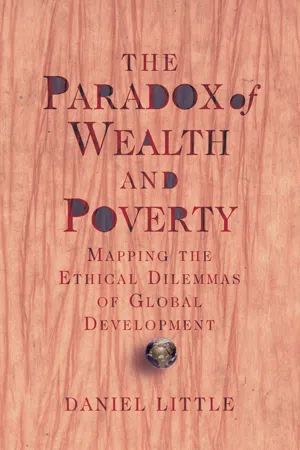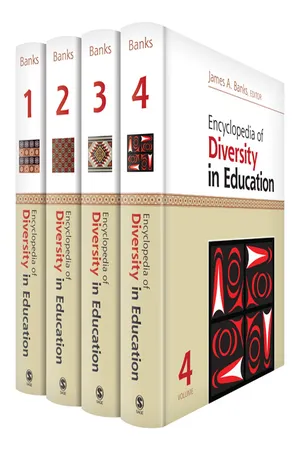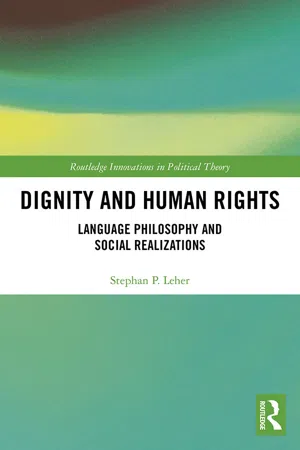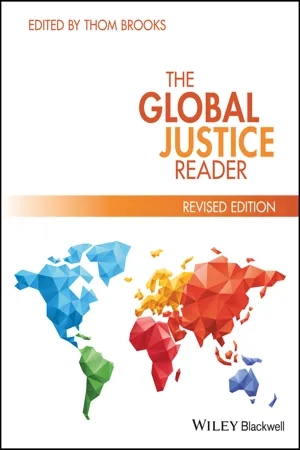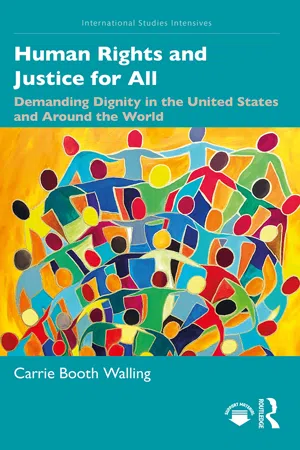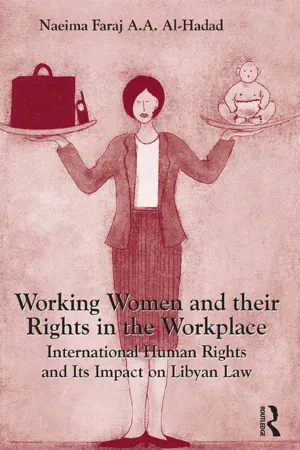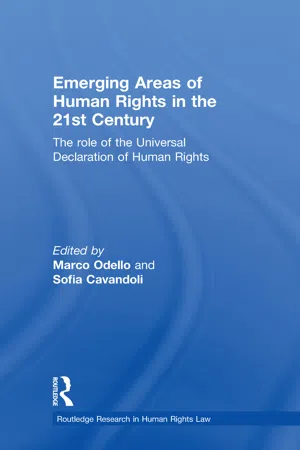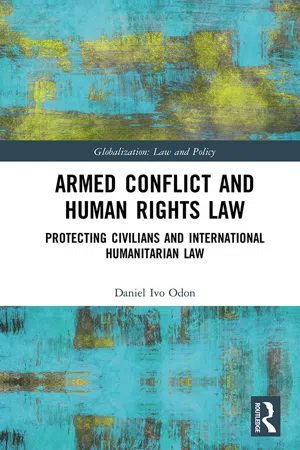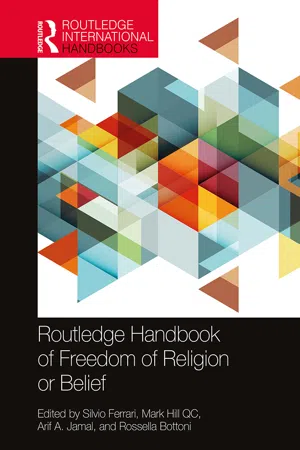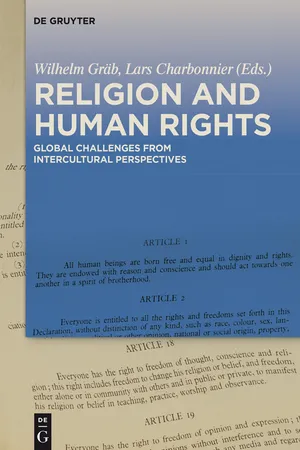Law
Universal Declaration of Human Rights
The Universal Declaration of Human Rights is a milestone document in the history of human rights. It was adopted by the United Nations General Assembly in 1948 and outlines fundamental human rights to be universally protected. The declaration encompasses civil, political, economic, social, and cultural rights, serving as a foundation for international human rights law.
Written by Perlego with AI-assistance
Related key terms
12 Key excerpts on "Universal Declaration of Human Rights"
- eBook - ePub
The Paradox Of Wealth And Poverty
Mapping The Ethical Dilemmas Of Global Development
- Daniel Little(Author)
- 2018(Publication Date)
- Routledge(Publisher)
It is worthwhile noting that the declaration falls somewhere between a philosophical treatise and a legal document. A treatise puts forward the author's conclusions or positions on one or more moral issues, along with a set of reasons designed to lead the reader to agree with these conclusions. A legal document is the result of a process of negotiation among legislators and is therefore a compromise document. Further, a legal document is designed to have compulsory force. It is intended to establish rules or principles that a political agency will then enforce with the coercive authority of the state. The UDHR is plainly a document that has emerged through a process of negotiation that is legislative-like; it reflects efforts by its various authors to accommodate the concerns or objections of some of the signatories. So it is a document that has greater authority than a philosophical treatise, but at the same time, because the United Nations is not a state with full powers of enforcement, the UDHR falls short of full legislative status (along the lines of the U.S. Bill of Rights, for example). The UDHR affords a point of moral leverage for citizens and groups whose rights have been abridged by their own governments or private organizations. It also provides a fulcrum within international law allowing groups to bring grievances to international tribunals such as the European Court of Human Rights or United Nations Commission for Human Rights.I will now examine the content of the universal declaration. (The text is readily available on the World Wide Web at www.un.org/Overview/rights.html .) The preamble to the declaration highlights the permanent importance of human rights and notes the language of the UN Charter to this effect: "Whereas the peoples of the United Nations have in the Charter reaffirmed their faith in fundamental human rights, in the dignity and worth of the human person and in the equal rights of men and women and have determined to promote social progress and better standards of life in larger freedom." The universal declaration is offered as an explicit articulation of understanding of the content of universal human rights.The first fourteen clauses enumerating rights in the UDHR fall in the category of civil and political rights: freedom from torture, freedom from enslavement, equality before the law, freedom of association. The declaration then moves to rights of citizenship, family, and property (clauses 15-17); rights of conscience, thought, and religion (clauses 18-19); and rights of democratic participation and association (clauses 20-21). - eBook - ePub
- James A. Banks(Author)
- 2012(Publication Date)
- SAGE Publications, Inc(Publisher)
Understanding, tolerance, and friendship are not limited to strangers in distant places but also apply to those with different identities within the nation and the school community. The aims of education address all humanity, thus defining human rights education and respect for diversity in a cosmopolitan framework. It supports the notion that we have obligations to others beyond those we make to family, friends, and to our fellow citizens. If we respect and value not just humanity in general, but the individual lives of others, we are required to show interest and respect for those practices and beliefs that give their lives significance. The UDHR can be understood as encapsulating a cosmopolitan vision, drawing on the 18th-century Enlightenment philosophy of Immanuel Kant.The Concept of Universality
Unlike previous declarations asserting equality of rights, notably the U.S. Declaration of Independence (1776) and the French Declaration of the Rights of Man and of the Citizen (1789), the UDHR introduced and codified the concept of universal human rights that are not the gifts of national governments but transcend the laws of sovereign states. Universality places on nation-states the obligation to protect the human rights not just of citizens, but of all living within their territories. The right to education extends to all, including displaced persons, migrants, asylum seekers, and refugees. For example, all inhabitants of the 47 member-states of the Council of Europe enjoy the protection of their rights under the European Convention on Human Rights 1950, which gives legal force to specific rights guaranteed under the UDHR, regardless of whether individuals enjoy the citizenship of a member-state. Those who fail to secure justice in national courts can appeal to the European Court of Human Rights. Judgments are binding on nation-states.Human rights provide a way of looking at the world. Since the UDHR, we have a global consensus on human rights and a shared language to describe ways in which human dignity may be violated. Rights are rarely achieved without struggle. The shared language of rights enables solidarities between groups struggling to overcome discrimination and injustice, regardless of the grounds for such discrimination. For example, the African National Congress framed the struggle against apartheid as a human rights struggle, attracting the support of UN agencies, nongovernmental groups, and governments. - eBook - ePub
Dignity and Human Rights
Language Philosophy and Social Realizations
- Stephan P. Leher(Author)
- 2018(Publication Date)
- Routledge(Publisher)
2 On Human Rights Day in 2008 the UN proudly asserted that,This statement by the UN expresses the nucleus of the UDHR, together with an assessment of the importance of this commitment for the future development of Human Rights law.adopted in 1948, the UDHR has inspired a rich body of legally binding international human rights treaties … It represents the universal recognition that basic rights and fundamental freedoms are inherent to all human beings, inalienable and equally applicable to everyone, and that every one of us is born free and equal in dignity and rights. Whatever our nationality, place of residence, gender, national or ethnic origin, color, religion, language, or any other status, the international community on December 10, 1948, made a commitment to upholding dignity and justice for all of us.3The Drafting Process of the Universal Declaration of Human Rights
I am grateful to the UN for putting online the documents, protocols and reports that testify to the drafting process of the UDHR.4 It is important that every citizen of the world have free access to the history of the making of this Declaration. The assessment of the claims set out by the UDHR by every single individual living on this earth now and in the future determines the degree of the social realization of the Declaration. When describing the drafting process of the UDHR, I will refer to the documents as numbered by the UN’s Dag Hammarskjöld Library.The Human Rights Commission was established in June 1946 by the Economic and Social Council of the UN.5 In January 1947, Eleanor Roosevelt (United States) was elected Chairman, Pen-Chun Chang (China) Vice-Chairman and Charles Malik (Lebanon) was chosen to be Rapporteur at the first meeting to draft the UDHR. Because the members had different views throughout the drafting process, the Human Rights Commission simultaneously worked on drafting a legal instrument with a strong enforcement component and an international bill of rights that would act as a standard-setting document for Human Rights.6 - eBook - ePub
- Thom Brooks(Author)
- 2023(Publication Date)
- Wiley-Blackwell(Publisher)
While the concept of human rights has been with us only a relatively short while, its importance in our normative and political assessment of domestic and international institutions has become widespread. Much hinges on what might serve as a human right and its violation. The chapters in this section aim to help us make best sense of this crucial area of concern.Passage contains an image
6 Universal Declaration of Human Rights
United NationsOn December 10, 1948, the General Assembly of the United Nations adopted and proclaimed the Universal Declaration of Human Rights, the full text of which appears in the following pages. Following this historic act the Assembly called upon all Member countries to publicize the text of the Declaration and “to cause it to be disseminated, displayed, read and expounded principally in schools and other educational institutions, without distinction based on the political status of countries or territories.”Preamble
Whereas recognition of the inherent dignity and of the equal and inalienable rights of all members of the human family is the foundation of freedom, justice and peace in the world,Whereas disregard and contempt for human rights have resulted in barbarous acts which have outraged the conscience of mankind, and the advent of a world in which human beings shall enjoy freedom of speech and belief and freedom from fear and want has been proclaimed as the highest aspiration of the common people,Whereas it is essential, if man is not to be compelled to have recourse, as a last resort, to rebellion against tyranny and oppression, that human rights should be protected by the rule of law, Whereas it is essential to promote the development of friendly relations between nations,Whereas the peoples of the United Nations have in the Charter reaffirmed their faith in fundamental human rights, in the dignity and worth of the human person and in the equal rights of men and women and have determined to promote social progress and better standards of life in larger freedom,Whereas Member States have pledged themselves to achieve, in co‐operation with the United Nations, the promotion of universal respect for and observance of human rights and fundamental freedoms, Whereas a common understanding of these rights and freedoms is of the greatest importance for the full realization of this pledge, - eBook - ePub
Human Rights and Justice for All
Demanding Dignity in the United States and Around the World
- Carrie Walling(Author)
- 2022(Publication Date)
- Routledge(Publisher)
Human rights are the rights every human being is born with. Human rights are about more than survival; they include those things that are essential to a life of dignity. These rights never go away even if those in power do not recognize them – they are inalienable. Human rights are universal. They are different than the rights granted by governments to their citizens. All human beings are born with human rights, do nothing to earn them, and their rights travel with them wherever they reside and no matter what border they cross. All human beings are equal in dignity and rights. Equality means that they apply to all persons regardless of gender, sex, race, religion, nationality, economic status, ability, sexual orientation, ethnicity, political belief, age, or any distinction of any kind. Importantly, all human rights are interdependent and interrelated. This means that human beings must have access to all their rights to achieve dignity. The violation of any single right limits the enjoyment of other rights. Human rights are an entitlement. They are not simply good or desirable. They are not a gift. People suffer harm when they are deprived of the human rights to which they are entitled. Although human rights are seldom fully realized, and often violated, that does not mean they do not exist. Rather, it is the deprivation of our human rights that mobilizes political action to claim them. In sum, human rights are the rights that every human is entitled to and are necessary for a life of dignity. Human rights are inalienable, equal, and interdependent.The content of our human rights are described in the Universal Declaration of Human Rights (UDHR) which passed without dissent in 1948 by the United Nations (UN) General Assembly, is legally codified in multiple international treaties, and was reaffirmed by UN members from all regions of the world through regional treaties and at the World Conference of Human Rights in 1993 and again in the UN 75 Declaration of 2020.1 Available in more than 500 languages and dialects, the UDHR is the most widely translated document in the world. The UDHR is composed of 30 articles which promote a shared vision of basic human rights and dignities that apply to all people in all nations (see Box 1.1). The preamble identifies respect for these human rights as, “the foundation of freedom, justice and peace in the world,” and disregard for human rights as barriers to their achievement. The 30 articles entail a variety of civil, political, economic, social, and cultural rights. These include the right to life (Article 3), peaceful assembly (Article 20), religion (Article 18), free and fair trial processes and humane treatment (Articles 5, 8–10), as well as reasonable work conditions, fair pay (Article 23), access to education (Article 26), and participation in cultural life and scientific advances (Article 27). By presenting these rights in a single document, the drafters signaled that these basic rights were interrelated and mutually reinforcing. For example, Article 6 says that everyone has the right to recognition as a person before the law – the right to a legal identity. The right to a legal identity is connected to every other human right in the UDHR and all the rights examined in this book. A legal identity is needed to access healthcare, education, to vote, to cross an international border, to open a bank account which is necessary for employment in the formal job sector, and to own property. Without access to a legal identity, people are uncounted and unprotected. Children without a legal identity are vulnerable to labor exploitation, human trafficking and enslavement, forced marriage, involuntary military service, and with no legal record of their existence there may be no record that they are missing. The World Bank estimates that more than 1 billion people worldwide lack a legal identity.2 - eBook - ePub
Social Work and Human Rights
A Foundation for Policy and Practice
- Elisabeth Reichert(Author)
- 2011(Publication Date)
- Columbia University Press(Publisher)
To begin a detailed study of human rights, the inevitable starting point is the Universal Declaration, adopted by the United Nations in 1948 and applicable to all countries joining that body (UN 1948). With the UN’s adoption of the declaration, a new historical era began in how nations viewed circumstances both inside and outside their borders. While the declaration had no immediate impact on domestic or international policies, over time the human rights principles contained in the declaration have frequently affected governmental policies and individual acts. Thus to say that human rights are simply words on paper does not reflect reality.Like any basic law or constitution, the Universal Declaration is a living document, subject to interpretations that continually change with the passage of time. But many of the declaration’s provisions contain fundamental freedoms and rights that would clearly apply to any set of circumstances.Americans Lack Knowledge About theUniversal Declaration of Human RightsIt appears odd that many Americans know little about the Universal Declaration of Human Rights, since the United States had much to do with its founding. Doug Pibel, the managing editor of Yes! magazine, made this point in a special edition of the magazine asking, Is the U.S. Ready for Human Rights?I am a child of an innocent time and place—the Great Plains in the golden years of the mid-20th century. I learned that the United States is the land of freedom and opportunity: the country that shows the way to rights for all. . . .But as I’ve learned our troubled history and seen our troubled present, I have come to question that story. I take no pleasure in my doubts. . . . The ideals I learned as a child are good ones: equality, prosperity for all, government by the people, and commitment to the common good. . . .Where are those ideals most clearly stated? The Bill of Rights is a good start. But the broadest statement is the Universal Declaration of Human Rights [UDHR]. It’s been described as one of the most important documents in human history, been translated into hundreds of languages, and formed the basis for national constitutions, yet it is little known in the United States. - eBook - ePub
Working Women and their Rights in the Workplace
International Human Rights and Its Impact on Libyan Law
- Naeima Faraj A.A. Al-Hadad(Author)
- 2016(Publication Date)
- Routledge(Publisher)
She suggests that every person has a role to play in the promotion of the implementation of international standards, and that each person needs to be aware of the implication of those standards for their everyday lives and that of others. 37 That progress, however substantial, still has a way to go, is reflected in her observation that although ‘[h]uman rights have universal ownership’ and are a much celebrated idea, they remain to be turned into ‘a reality’. 38 Universal Declaration of Human Rights (UDHR) The United Nations Universal Declaration of Human Rights lies at the core of the International Bill of Human Rights and ‘reflects the claims of humanity in a community of states’. 39 Its first Article clearly states that: All humans are born free and equal in rights. They are endowed with reason and conscience and should act towards one another in a spirit of brotherhood. 40 Formerly, states were able to hide behind the ‘veil of sovereignty’, 41 but now a new era was heralded as the rights of the individual state and the international community’s representative body became increasingly a contested area, particularly when countries agreed to participate in various treaties and conventions to which they then became bound and which involved them in an inspectorial or reporting process (for example, CRC, CEDAW and so on). The crucial shift was from ‘the protection of the sovereigns to the protection of the people’. 42 Article 21(3) raises a quite obvious challenge to the notion of state sovereignty by stating that government power and authority has to be based ‘on the will of the people’. 43 This must pose a particular challenge for both true monarchies and autocratic dictatorships, neither of which satisfy the apparent demand for elected forms of government - eBook - ePub
Emerging Areas of Human Rights in the 21st Century
The Role of the Universal Declaration of Human Rights
- Marco Odello, Sofia Cavandoli(Authors)
- 2012(Publication Date)
- Routledge(Publisher)
3 The contribution of the Universal Declaration of Human Rights to the promotion and protection of democracy in international law Richard Burchill and Sofia Cavandoli3.1 IntroductionThis chapter puts forth the proposition that the Universal Declaration of Human Rights (UDHR) holds an important place with regard to the promotion and protection of democracy in international law. Our argument is that the UDHR serves as a foundation for understanding the meaning, content and parameters of democracy as an international legal principle. Commentators have attempted to claim that the adoption of the UDHR in 1948 gave rise at that time to an international right to democratic governance.1 Clearly, the reality of the international system from 1948 showed that such a right was non-existent as international law and took minimal notice of the structures or processes of government and governance. International law’s attention to governance took a major turn with the end of the Cold War. In both practice and rhetoric, international law was utilised to engage in the promotion and protection of democracy. While there has been widespread evidence of support expressed for democracy in both international law and relations, determining the meaning of what is at stake remains a critical issue to be addressed.We will assert that the UDHR provides substantial guidance for defining democracy in international law as it contains the core elements of a definition of democracy that covers procedures, substance and a normative basis. The UDHR does not establish a detailed framework for democracy as democratic practices will vary and a degree of pluralism in understanding democracy is necessary. What the UDHR does provide is the parameters for understanding what constitutes democracy in international law as well as normative support for the pursuit of more effective democratic systems. As the UDHR is not a legally binding document its contribution to the promotion and protection of democracy in international law does not come in the form of legal obligations but rather as normative support that has widespread acceptance. This chapter will begin with a brief discussion of international law and the promotion and protection of democracy in order to highlight the definitional issues that are at stake. The next section will discuss the drafting of the UDHR focussing on debates concerning the nature of government and governance before undertaking an assessment as to how the final version of the UDHR supports an understanding of democracy. The adoption of the UDHR was a revolutionary development in international law as it marked the first significant effort to restrain the exercise of government by reference to the promotion and protection of human interests over state interests. The development of an international law of democracy in the post-Cold War period has also marked a major development in the nature of international law and relations. In both cases these developments can be seen as efforts ‘to promote social progress and better standards of life in larger freedom’,2 - eBook - ePub
Armed Conflict and Human Rights Law
Protecting Civilians and International Humanitarian Law
- Daniel Ivo Odon(Author)
- 2021(Publication Date)
- Routledge(Publisher)
per se. Rather, it helps international courts set their jurisprudence based on interpretation of human dignity and embeds it into rights assured by human rights treaties. Additionally, the UDHR of 1948 offers the statement that “all human beings are born free and equal in dignity and rights”, which sets a new moral paradigm requiring the equal and respectful treatment of all people simply by virtue of being human. At the back of these documents rests the hope that the acknowledgment of human dignity can bring abuse and cruelty to an end.As observed by Erin Daly, the interpretation of human dignity comes with enormous cultural baggage all around the world and dignity does not transform into a right at first glance.78 On the UDHR’s behalf, the preambles of the International Covenant of Civil and Political Rights (ICCPR) and International Covenant of Economic, Social and Cultural Rights (ICESCR) recognize dignity as the inheritance of all humanity and assert the “equal and unalienable rights of all members of the human family as the foundation of freedom, justice and peace in the world, recognizing that these rights derive from the inherent dignity of the human person”. From that moment on, dignity is not a mere value, but the centrepiece that roots all fundamental rights, the cardinal value .79 This was exemplified at the Convention on the Elimination of All Forms of Discrimination against Women of 18 December 1979, when the preamble emphasized in particular that discrimination against women “violates the principles of equality of rights and respect for human dignity”. It becomes a supervalue placed in between law and morality in such a way that the former can only be founded on the latter as a legitimate rationale.80 - Silvio Ferrari, Mark Hill QC, Arif A Jamal, Rossella Bottoni, Silvio Ferrari, Mark Hill QC, Arif A Jamal, Rossella Bottoni(Authors)
- 2020(Publication Date)
- Routledge(Publisher)
In 1948, in the aftermath of the Second World War, the Universal Declaration of Human Rights (UDHR) was adopted by the General Assembly of the United Nations. Article 18 of the UDHR proclaims:Everyone has the right to freedom of thought, conscience and religion; this right includes freedom to change his religion or belief, and freedom, either alone or in community with others and in public or private, to manifest his religion or belief in teaching, practice, worship and observance.Also relevant from the viewpoint of religious freedom is Article 2 of the UDHR, which prohibits discrimination on grounds of inter alia religion.Albeit formally not a legal binding document, the UDHR is generally considered a powerful source of moral obligation in the field of human rights. Its importance is reflected by the fact that the manner in which human rights have been framed in the UDHR has subsequently exercised a strong influence on the drafting of legally binding human rights provisions at the international, regional and national levels.In 1966, with a view to translating the rights enshrined in the UDHR into sources of legal obligation, two International Covenants were adopted within the UN framework: the International Covenant on Civil and Political Rights (ICCPR) and the International Covenant on Economic, Social and Cultural Rights (ICESCR). Both Covenants entered into force in 1976 and enjoy wide ratification by 172 and 169 States, respectively (as of September 2018). Of particular importance is Article 18 § 1 of the ICCPR, which strongly resembles the corresponding provision from the UDHR:Everyone shall have the right to freedom of thought, conscience and religion. This right shall include freedom to have or to adopt a religion or belief of his choice, and freedom, either individually or in community with others and in public or private, to manifest his religion or belief in worship, observance, practice and teaching.- eBook - ePub
- Wilhelm Gräb, Lars Charbonnier, Wilhelm Gräb, Lars Charbonnier(Authors)
- 2015(Publication Date)
- De Gruyter(Publisher)
Both of them combined this universal approach with a confessional base: Because it is God who makes all human beings, apart from what differentiates them, as beings standing under God, the Supreme Being and their Creator, human beings should have equal rights. This religious meaning also becomes obvious in talk of “inherent dignity”. The language of inherent dignity places human rights under conditions that are ineluctably given to every human being and which cannot be the subject of negotiation in the specific communities to which human beings belong. Human dignity belongs to every human being in an unconditioned way. This is precisely what it means to see someone through the eyes of faith. At the end of the 18 th century this faith could be easily pronounced as faith in God, the Creator. In the UN-Charter the confessional foundation of the universal approach of human rights had to change, even though only semantically. Only with such a change it was possible for so many different cultural and religious traditions to accept and adopt the Declaration. This cultural transformation and adaption is in fact what happened at the beginning and merged in the process of placing the Declaration of Human Rights in different cultural and religious traditions. The process is not at all completed and is, with regard to religion, often controversially discussed because the role of religion in human rights discourse often becomes closely related to specific religions. And then one often sees oneself, of course, quickly involved in a very ambivalent history. One has to confess that Christian churches accepted the idea of human rights quite late and even today often accused of not advocating for human rights very strongly. Religions have their own legal orders that can lead to conflicts with national law and even with human rights, especially in cases where human rights have entered into state legal orders - eBook - ePub
Dignity and International Human Rights Law
An Introduction to the Punta del Este Declaration on Human Dignity for Everyone Everywhere
- Brett Scharffs, Ewelina Ochab(Authors)
- 2021(Publication Date)
- Routledge(Publisher)
5 Article 3Defining and specifying human rights
DOI: 10.4324/9781003207030-6Article 3 reads as follows:The following is an expanded explanation of each part of Article 3.Dignity is an essential part of what it means to be human. Respect for human dignity for everyone everywhere helps us define and understand the meaning and scope of all human rights. Focusing concretely and in actual situations on human dignity and its implications for particular human rights claims can help identify the specific content of these rights as well as how we understand human dignity itself.
Dignity is an essential part of what it means to be a human. Denying or violating the dignity of a person entails denying or violating the very cornerstone of what it means to be a human.a. Dignity is an essential part of what it means to be humanDefinitions of human dignity
As we have seen, as the drafters of the UDHR looked for principles upon which they could build the edifice of human rights, human dignity emerged as one of the key concepts sufficiently broad enough to be accepted (by the drafters with diverse backgrounds and representing different Weltanschauung ) and morally appealing enough to further the work, along with related concepts such as “reason,” “conscience,” and the need to treat each other with a “spirit of brotherhood.”As we’ve also seen, dignity is an important concept in a large number of religious and non-religious normative systems. We can learn a lot about the shape and meaning of dignity by looking closely at how the term is defined by various thinkers and authorities within a variety of (religious and non-religious) traditions and (philosophical and non-philosophical) systems of thought. We can also learn from thoughtful ordinary people who reflect upon what dignity means in their eyes.
Index pages curate the most relevant extracts from our library of academic textbooks. They’ve been created using an in-house natural language model (NLM), each adding context and meaning to key research topics.
